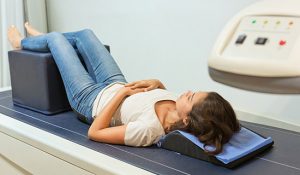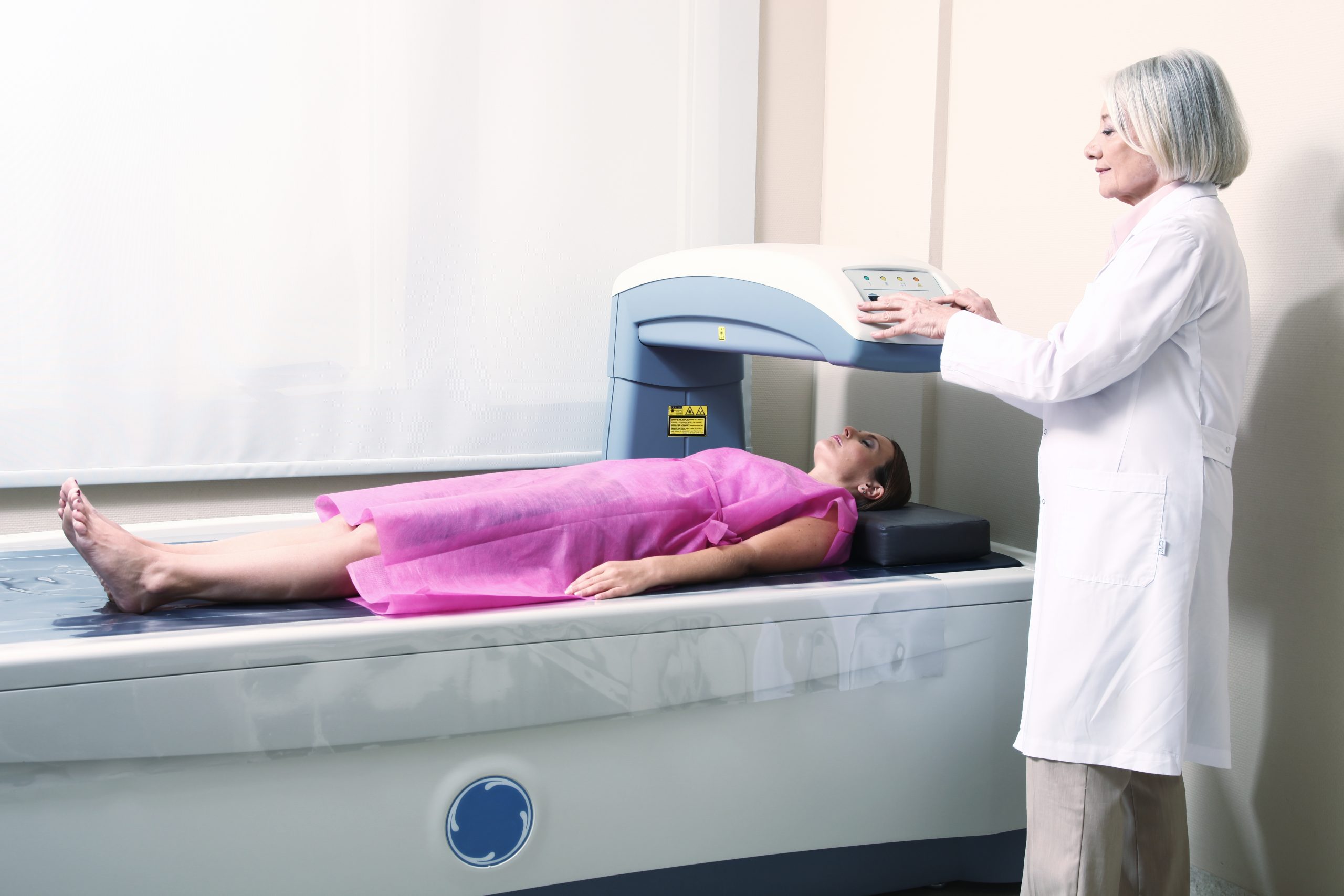Bone densitometry ( density measurement )
Bone densitometry, bone density measurement is possible with special computer programs and densitometry devices that make precise measurements without requiring any preparation, without causing any harm to the body. Regional (such as lumbar vertebrae, hip joint, wrist) and whole body analyses can be performed. In addition, the amount of fat and November of the body can also be determined.
Which disease is bone densitometry used for diagnosis and follow-up ?
Osteoporosis is a skeletal disease that leads to an increased risk of bone fractures as a result of a decrease in bone mass and deterioration in the microscopic structure of bone tissue.
In women, loss of bone mass begins after the age of 40. This condition accelerates with menopause. On average, 15% of bone mass is lost for the first ten years of menopause in women, and 20-30% for men throughout their entire life. As the rate of loss of bone mass increases, the risk of fractures increases.
With bone density measurement, both the risk of osteoporosis and fractures can be calculated and follow-up can be performed after treatment. Bone density measurement in patients diagnosed with osteoporosis and treated, the duration of recurrence varies depending on the degree of ostreopause and the treatment provided, but spine and hip bone density measurement is performed once a year in high-risk menopausal patients and once every 5 years in low-risk patients.
Osteoporoz
|
Endogenous (Internal Factors)genetics (white, black, asian)
thin, delicate structure
Light color
The family history of osteoporosis
Age
Female gender
Early and surgical menopause
Medical diseases
|
Exogenous (External Factors)nutrition (Ca, Phosphorus,Protein)
Sedentary life (Relaxed and Lazy)
Lifestyle(Smoking, coffee, alcohol)
Sunlight deprivation
Immobilization
Medications
Thyroid hormone
Chemotherapy
|
Ostreoporosis (bone resorption) has started to become an important health problem in Turkey. The risk of osteoporosis increases in menopausal women, men over 55, those who remain inactive for a long time, those who lack dairy products, certain diseases (such as digestive system-related diseases), various drug use and excessive coffee consumption. If the symptoms of osteoporosis, back and lower back stiffness, night sweats, weakness, hunchback, shortening of height are done early, the treatment will be just as face-pleasing.
What is a Bone Density Measurement?
Bone density scans are an indirect indicator that many doctors use to help determine whether you have osteoporosis. The procedure, also called a bone mineral density test, measures how much bone material is in your bones per square centimeter.
Osteoporosis is a disease that makes your bones more fragile and prone to breaking. Bone density scans use X-ray technology to measure the amount of calcium and bone minerals packed into a small part of your bone. The test is usually performed on the spine and hip. If your bone mineral content is high, your bones are denser and less likely to break. However, the low bone mineral content means that your bones are at risk of fracture and may indicate osteoporosis.

Areas of Use for Bone Density Measurement
Before the use of bone density scans began, doctors could only tell if a patient had osteoporosis when a bone was broken. But at this point, the disease has progressed and the bones will already be in a bad condition. Older women are the most common demographic for this condition. However, everyone can develop osteoporosis, regardless of their age or gender.
If you have some of the following risk factors, your doctor may recommend a bone density scan:
Shortening in height, brittle bones that are more prone to fracture, if you are taking certain medications that interfere with the bone reconstruction process, transplant patients using medications that prevent rejection of the transplant organ, low sex hormone levels
Bone densitometry has various uses:
Checking whether your bone density has decreased , determining whether there is a high risk of breaking your bones, confirming the diagnosis of osteoporosis, monitoring the progression of osteoporosis, reviewing the effectiveness of osteoporosis treatments
How is Bone Density Measurement Performed ?
Bone density measurement is a quick and painless procedure that usually takes about 10 to 30 minutes to complete. The examination is usually performed on bones that are more prone to fracture due to osteoporosis, such as bones in your spine, thigh bone, or forearm.
When you come for a bone density measurement, one of our Hekimoğlu Imaging team members will place you at a packed table. The test is performed using a dual-energy X-ray absorptiometry (DXA, DEXA) machine. The device sends a low-dose X-ray. The image is created on a computer monitor.
As the scan continues, you will be asked to stand as still as possible, and you may need to hold your breath. This ensures that your image does not become blurred. Radiation exposure during the procedure is minimal and much less than that emitted by a chest X-ray.
When is Bone Density Measurement Performed?
Medical professionals use bone density tests to determine a patient’s diagnosis of osteoporosis. Understanding this procedure can help you know if you need it and when you need it.
Types of Bone Density Measurement
Technologists can perform various types of X-rays to test bone density. Most commonly, they use dual-energy x-ray absorptiometry, also known as DXA or DEXA. A DEXA test for bone density takes about 10 to 30 minutes. The technologist will use DEXA to look at bones that are prone to osteoporosis, such as your forearm bones, spine or thigh bone. Other types of bone density measurement include quantitative computed tomography (Q Dect) and single-energy x-ray absorptiometry (SXA).
Who Should Have a Bone Density Measurement?
The following factors affect whether you should have a bone density test:
Age: Bone density measurement may benefit women over the age of 65 and men over the age of 70, who are at a higher risk of osteoporosis due to age. Doctors usually recommend the test to people of this age when there is a moderate risk of fractures.
Medical history: Certain medical disorders and medications may affect your risk of developing osteoporosis. Conditions such as diabetes, liver disease, kidney disease, and rheumatoid arthritis can reduce bone density.
Other osteoporosis risk factors: Several other factors may make you more prone to osteoporosis. People with smaller frames or a family history of osteoporosis may also require a bone density test.
Reasons for Bone Density Measurement
Since bone density tests accurately detect a patient’s bone material, they have many uses. Doctors request these scans for a variety of purposes, including:
Making the first diagnosis of osteoporosis
Determination of the patient’s bone fracture risk
Monitoring of the patient’s bone density
Understanding the effectiveness of osteoporosis treatment
Checking the progression of osteoporosis
How Often Is Bone Density Measurement Performed During Osteoporosis Treatment?
Doctors have different opinions about how often a person should have a bone density measurement after the first one. According to some opinions, patients do not need more than one test within the first three years after the diagnosis of osteoporosis. According to some opinions, a bone density test should be performed every one or two years during the treatment of osteoporosis.
What Does Bone Density Measurement Tell You About Bone Health?
The bones support the rest of the body, providing all kinds of movement and activity. Over time and in conditions such as osteoporosis, bones can lose some of their density, which increases the likelihood of fracture. If you have risk factors or symptoms of bone loss, your doctor may recommend a bone densitometry (DEXA) scan .
What is a DEXA Scan?
A DEXA scan is an imaging test used to measure bone mineral density. In this type of bone density scan, two x-rays are directed to the bones. The amount of radiation absorbed indicates how tightly packed the minerals are in the bone segment being tested.
To get the most accurate results, radiologists focus DEXA scans on the parts of the body that are most vulnerable to fractures caused by osteoporosis, especially the hips and spine. If you are unable to have a scan aimed at the hip or spine – for example, due to a hip replacement – the scan will target the forearm instead.
DEXA screenings are recommended for women over the age of 65, men over the age of 70, and anyone with risk factors for osteoporosis.
How to Read the Bone Densitometry Measurement and What Do the Results Tell You About Bone Health?
By accurately measuring bone density, a DEXA scan can tell you whether you have osteoporosis, whether you are likely to develop osteoporosis, and whether you may benefit from medications to slow bone loss.
When the results of your scan come in, your doctor will probably give you a number two. The first one is a T-score. This compares your results to the bone density of a healthy 30-year-old:
a T score greater than -1 is considered normal
a T-score between -1 and -2.5 indicates osteopenia……….Dec………..
a T score lower than -2.5 indicates osteoporosis
The second number provided with your results is a Z-score that compares your bone density to the average according to your age, weight, gender and ethnicity. A Z-score above 2.0 is considered normal, while a Z-score below -1.5 may indicate a condition that contributes to bone loss other than age.
Bone Densitometry Prices 2025
You can contact us immediately to get information about bone densitometry prices 2025.

